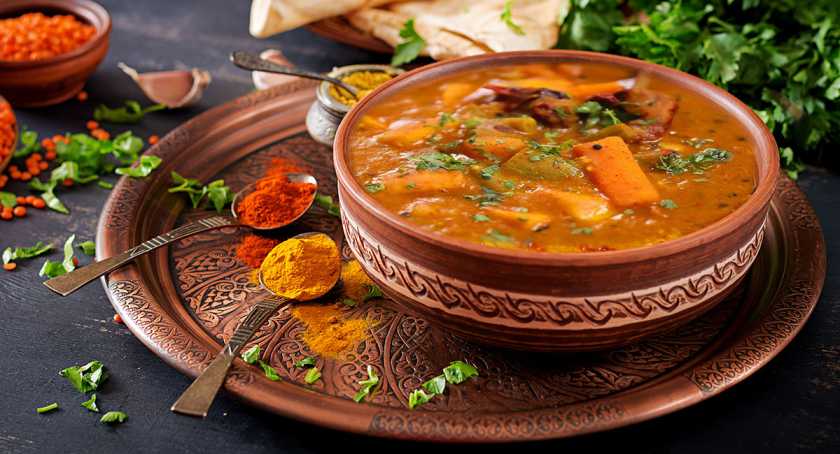Dalma: The Signature Odia Dish with a Healthy Touch
Odia cuisine is known for its simplicity, balanced flavors, and nutritional value. Among the many delightful dishes from Odisha, Dalma holds a special place in the hearts of locals. This wholesome lentil-based dish, enriched with vegetables and spices, is a culinary delight and a representation of Odisha’s rich cultural and culinary heritage. Unlike many other lentil preparations across India, Dalma is unique in its ingredients, cooking method, and cultural significance. Whether served in a temple as a prasad or enjoyed in an Odia household, this dish embodies warmth, nourishment, and tradition.
Origins of Dalma
Dalma is deeply rooted in Odia traditions and has been a staple food for centuries. It is essential to daily meals, temple offerings, and festive occasions. The Jagannath Temple in Puri is closely associated with the dish, which priests prepare as part of the Mahaprasad (sacred food offered to Lord Jagannath). As per temple customs, food delivered to the deity must be free of onion and garlic, adhering to sattvic (pure) dietary principles in Hinduism. Dalma, cooked without these ingredients, aligns perfectly with these traditions and is enjoyed as a sacred and wholesome meal.
Historically, Odisha has been an agrarian society, and Dalma reflects this heritage. It uses locally available vegetables, lentils, and spices, creating a nutritious and sustainable dish. Farmers and households have relied on Dalma for generations as a complete meal that provides essential nutrients and energy. Over time, different regions in Odisha have developed their variations, but the essence of Dalma remains the same—wholesome, flavorful, and deeply satisfying.
Ingredients of Dalma
Dalma is a nutritious combination of lentils and vegetables, making it a complete meal. The key ingredients include:
Lentils:
- The base of the dish is arhar dal (pigeon peas) or moong dal (yellow lentils), which are rich protein sources.
Vegetables:
- Pumpkin
- Raw banana
- Papaya
- Brinjal
- Drumsticks
- Potatoes
These vegetables enhance the taste and add essential vitamins, minerals, and fiber, making Dalma a well-balanced dish.
Spices:
- Cumin seeds
- Dry red chilies
- Turmeric
- Bay leaves
- Ginger
- Asafoetida
These mild yet aromatic spices elevate the dish’s flavors without overpowering its natural taste.
Tempering:
- Ghee
- Mustard seeds
- Grated coconut (optional)
Ghee enhances the dish’s aroma and adds a touch of richness.
Garnish:
- Fresh coriander leaves
- Grated coconut (for added flavor and texture)+++
Each ingredient contributes to the dish’s wholesome nature. It is a well-balanced meal for all ages, providing a rich blend of protein, fiber, vitamins, and minerals.
The Art of Preparing Dalma
Making Dalma is a simple yet refined process that brings out the best flavors of the ingredients. The method is easy to follow and ensures that the natural essence of lentils and vegetables remains intact.
Step-by-Step Preparation:
- Cook the Lentils: Wash and cook arhar dal or moong dal in a pressure cooker with water, turmeric, and salt until soft.
- Add Vegetables: Once you partially cook the dal, chop the vegetables and add them, allowing them to cook until tender.
- Prepare the Tempering: Heat ghee in a separate pan and add cumin seeds, bay leaves, dry red chilies, and asafoetida. Stir until aromatic.
- Combine Everything: Pour the tempering into the cooked dal and vegetables. Stir well to mix the flavors.
- Final Touch: Add grated coconut and fresh coriander leaves for an enhanced taste.
- Serve Hot: For an actual Odia experience, steamed rice and a dollop of ghee complement Dalma well.
Dalma in Odia Culture
Dalma is more than just food; it reflects Odisha’s agrarian roots and cultural traditions. It is a staple in every Odia household and a must-have during festivals like Rath Yatra and Makara Sankranti. In temples, Dalma is served as a prasad, symbolizing purity and devotion. Its widespread presence in Odia cuisine shows its importance as a daily meal and a sacred and festive dish.
Variations of Dalma
Different regions in Odisha have their versions of Dalma, each offering a unique taste and texture:
- Chhatu Dalma: Made with mushrooms for an earthy flavor.
- Badhi Dalma: Includes sun-dried lentil dumplings (badhi) for added texture.
- Moong Dalma: Uses roasted moong dal for a nuttier taste.
- Masala Dalma: A spicier version, incorporating garam masala for an extra kick.
Why Dalma Stands Out?
Dalma is distinct from other dal preparations in Indian cooking due to its use of vegetables, absence of garlic and onion, and unique tempering method. This combination of components makes the dish tasty, light, well-balanced, and complete. The dish’s sattvic nature makes it ideal for everyone, including those on a religious diet, and its inclusion of seasonal vegetables guarantees freshness and nutrients.
Final Thoughts
Dalma is more than just a dish; it symbolizes Odisha’s culinary heritage, simplicity, and nutritional wisdom. Whether served at home, in temples, or during festivals, Dalma remains a beloved staple in Odia cuisine. Its wholesome ingredients, easy preparation, and deep-rooted cultural significance make it a must-try dish. If you haven’t tried it yet, make sure to cook or taste this wholesome dish and experience the authentic flavors of Odisha.
So, the next time you crave comfort food with a healthy twist, remember Dalma – the signature Odia dish with a wholesome touch!


